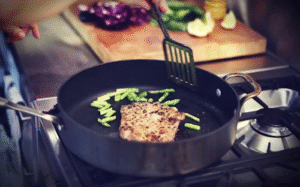In the world of cookware, trends come and go. Yet, one category has consistently earned the respect of professional chefs and home cooks alike: clad stainless steel. You’ve likely seen these pans with their distinctive, slightly ridged sides, but what makes them so special? More than just a beautiful addition to your kitchen rack, a clad stainless steel pan is a masterclass in engineering, designed to deliver unparalleled performance and durability.
Let’s break down exactly why this pan might be the last one you ever need to buy.
First, What is “Clad” Construction?
The secret lies in the name. Unlike a pan made from a single material, “clad” or “multi-ply” pans are constructed by bonding together layers of different metals. Typically, this involves a core of highly conductive metals—like aluminum or copper—sandwiched between two layers of resilient stainless steel.
Think of it as a culinary super-sandwich: the stainless steel provides the tough, non-reactive exterior and interior, while the inner core acts as a superhighway for even heat distribution.
The Top Benefits of Cooking with Clad Stainless Steel
1. Unbeatable Even Heat Distribution
This is the flagship benefit. Have you ever had a pan that creates a blazing hot spot in the center while the edges remain cool? That leads to unevenly cooked food—burnt on one side, undercooked on the other. The aluminum or copper core in a clad pan spreads heat quickly and uniformly across the entire cooking surface, including the sides. This means your seared steaks develop a perfect, all-over crust, your sauces cook without scorching, and your pancakes are golden brown from edge to edge.
2. Superior Heat Responsiveness
While cast iron is a fantastic heat retainer, it’s slow to react when you adjust the temperature. Clad stainless steel offers a beautiful balance. The core responds promptly to changes on your stovetop knob. If your pan is getting too hot, simply lower the heat, and you’ll see a quick adjustment. This level of control is essential for delicate tasks like preparing a pan sauce or gently cooking fish.
3. The Ultimate Searing Machine
For that restaurant-quality, caramelized crust on meats, you need high, consistent heat and a surface that can handle it. Stainless steel excels here. It won’t flake or degrade under high temperatures like some non-stick coatings, allowing you to get a perfect, flavorful sear (thanks to the Maillard reaction) that locks in juices.
4. Incredible Durability and Longevity
A high-quality clad stainless steel pan is a buy-it-for-life item. It’s resistant to rust, corrosion, and staining. It won’t chip or crack like ceramic or non-stick coatings. It’s also typically dishwasher safe (though handwashing is recommended for longevity) and can withstand aggressive scrubbing with steel wool or abrasive cleaners to remove any stuck-on food—something that would ruin a non-stick pan.
5. A Perfectly Non-Reactive Cooking Surface
This is a crucial, yet often overlooked, benefit. Stainless steel is inert, meaning it won’t react with acidic or alkaline foods. You can simmer a tomato sauce, deglaze with wine, or reduce a lemon-butter sauce for hours without any risk of a metallic taste or the pan leaching into your food. This makes it infinitely more versatile than reactive metals like aluminum or cast iron (unless it’s well-seasoned) for a wide range of recipes.
6. Foundation for Flavorful Pan Sauces
The slight sticking that occurs when searing meat creates “fond”—those delicious, browned bits stuck to the bottom of the pan. This is flavor gold! After cooking, you can deglaze the pan with wine, stock, or vinegar, scraping up the fond to create incredibly rich and quick sauces that elevate any meal.
7. Stovetop-to-Oven Versatility
Most clad stainless steel pans are oven-safe, often with handles that can withstand high temperatures (typically up to 500°F or more). This versatility allows you to sear a pork chop on the stovetop and then finish it gently in the oven, or to make a frittata that starts on the burner and ends under the broiler.
Addressing the One Common Concern: Sticking
It’s true—clad stainless steel is not naturally non-stick like a Teflon-coated pan. However, “sticking” is often a matter of technique. The secret is proper preheating and fat management.
- Preheat your pan until a drop of water sizzles and dances across the surface (the “Leidenfrost effect”).
- Then add your oil or fat, letting it heat up for a moment.
- Finally, add your food. A properly preheated pan creates a microscopic layer of steam that prevents food from fusing to the surface.
The Verdict
A clad stainless steel pan isn’t about a single gimmick; it’s about mastering the fundamentals of cooking. It offers the precise control desired by bakers, the brute-force searing power needed for meats, and the gentle reactivity required for delicate sauces.
While it may require a slightly higher initial investment and a small learning curve to prevent sticking, the payoff is immense. It’s the reliable, versatile, and indestructible workhorse that will handle 90% of your stovetop cooking tasks for decades to come. In the quest for better cooking, a clad stainless steel pan isn’t just a tool—it’s an essential partner.

